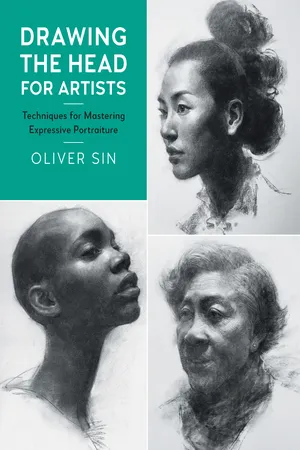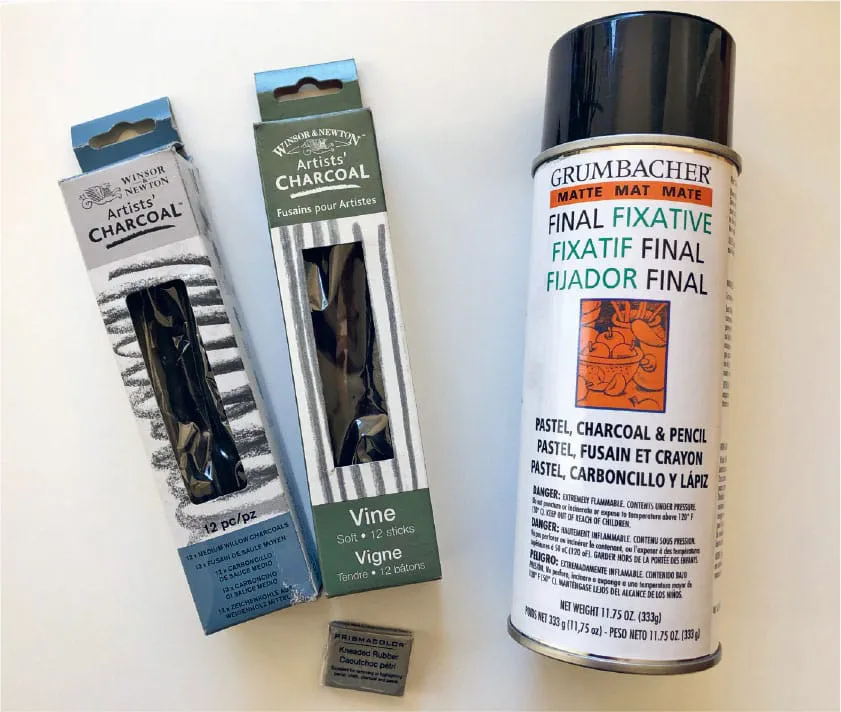
- 160 pages
- English
- ePUB (mobile friendly)
- Available on iOS & Android
eBook - ePub
About this book
Drawing the Head for Artists is the definitive modern guide to drawing the human head and portrait, featuring the classic mediums and methods of the Old Masters.
Written by celebrated portrait artist and veteran studio instructor Oliver Sin, this richly informative and beautifully illustrated volume leads readers step-by-step through his method, from establishing a point of view to applying the timeless principles for creating an accurate and expressive likeness.
Among the topics covered:
Brimming with striking images that document all the phases and details of the author’s process, Drawing the Head for Artists inspires and informs all artists, from aspiring to accomplished, on how to successfully portray the physical subtleties and emotional eloquence of the human face.
The For Artists series expertly guides and instructs artists at all skill levels who want to develop their classical drawing and painting skills and create realistic and representational art.
Written by celebrated portrait artist and veteran studio instructor Oliver Sin, this richly informative and beautifully illustrated volume leads readers step-by-step through his method, from establishing a point of view to applying the timeless principles for creating an accurate and expressive likeness.
Among the topics covered:
- Essential Materials & Techniques:Learn about necessary supplies and basic drawing techniques, including hatching, various stroke styles, and blending.
- Applying the Essentials: Explore how the concepts of sight-sizing, value, negative space/shapes, and plane changes factor into a portrait’s underlying structure.
- Techniques for Creating Depth & Dimension:Investigate how contrasting shapes, overlapping forms, and linear and atmospheric perspective are used to enhance depth.
- Creating the Illusion of Three Dimensions: Examine how edges—contours as well as changes in value—are used to convey three-dimensional form.
Brimming with striking images that document all the phases and details of the author’s process, Drawing the Head for Artists inspires and informs all artists, from aspiring to accomplished, on how to successfully portray the physical subtleties and emotional eloquence of the human face.
The For Artists series expertly guides and instructs artists at all skill levels who want to develop their classical drawing and painting skills and create realistic and representational art.
Frequently asked questions
Yes, you can cancel anytime from the Subscription tab in your account settings on the Perlego website. Your subscription will stay active until the end of your current billing period. Learn how to cancel your subscription.
At the moment all of our mobile-responsive ePub books are available to download via the app. Most of our PDFs are also available to download and we're working on making the final remaining ones downloadable now. Learn more here.
Perlego offers two plans: Essential and Complete
- Essential is ideal for learners and professionals who enjoy exploring a wide range of subjects. Access the Essential Library with 800,000+ trusted titles and best-sellers across business, personal growth, and the humanities. Includes unlimited reading time and Standard Read Aloud voice.
- Complete: Perfect for advanced learners and researchers needing full, unrestricted access. Unlock 1.4M+ books across hundreds of subjects, including academic and specialized titles. The Complete Plan also includes advanced features like Premium Read Aloud and Research Assistant.
We are an online textbook subscription service, where you can get access to an entire online library for less than the price of a single book per month. With over 1 million books across 1000+ topics, we’ve got you covered! Learn more here.
Look out for the read-aloud symbol on your next book to see if you can listen to it. The read-aloud tool reads text aloud for you, highlighting the text as it is being read. You can pause it, speed it up and slow it down. Learn more here.
Yes! You can use the Perlego app on both iOS or Android devices to read anytime, anywhere — even offline. Perfect for commutes or when you’re on the go.
Please note we cannot support devices running on iOS 13 and Android 7 or earlier. Learn more about using the app.
Please note we cannot support devices running on iOS 13 and Android 7 or earlier. Learn more about using the app.
Yes, you can access Drawing the Head for Artists by Oliver Sin in PDF and/or ePUB format, as well as other popular books in Art & Art General. We have over one million books available in our catalogue for you to explore.
Information
1
PORTRAIT DRAWING MATERIALS

KEY MEDIUMS & TOOLS
Vine Charcoal and Willow Charcoal
I use vine and willow charcoal sticks for my portrait drawings to achieve the chiaroscuro technique. Chiaroscuro, an Italian term meaning light (chiaro) and dark (oscuro), is used to enhance the dimensionality of drawings by creating smooth, subtle transitions among values.
Artists use vine and willow charcoal, which are made by burning vines or branches in a kiln, for their versatile properties. Sticks of vine and willow charcoal, which are fragile and break easily, are available in a variety of lengths, thicknesses, and densities or degrees of hardness. These mediums produce marks in a wide range of values, from very light to intensely dark, which suits them perfectly to the chiaroscuro technique.
Willow charcoal is black, while vine charcoal is dark gray. Vine charcoal’s lighter tone and ease of removal make it a favorite of artists for creating initial sketches or preliminary compositions, but it is less suitable for creating detailed artworks because it has a tendency to fade. Darker values can be achieved by applying willow charcoal over vine charcoal, or applying the two together. Vine charcoal can also be combined with other charcoal mediums, such as compressed charcoal.

Willow charcoal, a kneaded eraser, vine charcoal, and a spray can of final fixative
WORKING WITH VINE AND WILLOW CHARCOAL

1 | Break a charcoal stick into smaller pieces about 1 inch (2.5 cm) long. To hold the charcoal correctly, position it between the thumb and the first two fingers, and draw with the broad side rather than the tip to create an extremely soft-value stroke. If you hold a piece of charcoal as if to write with it, that angle will produce a hard line, which is undesirable. Value is the most basic element in my portrait drawings, and I use line minimally, usually only in conjunction with massing to clarify edges and details.

2 | Practice changing strokes from value to hard line, then from hard line to value, applying soft pressure as if you’re caressing the drawing surface, so that you may use your finger to blend the charcoal into the paper.
Kneaded Eraser
When working with vine and willow charcoal, I use a kneaded eraser to remove, lift, and redistribute values.
Because kneaded erasers can be easily stretched and shaped, they’re excellent for subtractive work, to shape form, refine line-work, and create highlights.
Other helpful tools for subtracting and manipulating values are retractable erasers, gum erasers, extra-soft erasers, single-edged razor blades, and bristle brushes. The narrow head of a retractable eraser allows for greater control in adjusting details.
Safety Note
Both workable and final fixatives are toxic, so only use them outdoors.
Fixative
Unfixed charcoal drawings are extremely vulnerable to surface damage. The slightest movement or an accidental touch can leave a noticeable smudge, reduce the intensity of value, and muddy highlights. Fixative can actually strengthen a drawing, allowing for additional layering by acting as a “glue” for a new application of medium, and ensuring that fine dustings are not lost.
Use a workable fixative while a drawing is in process. Note that fixative will change the appearance of a charcoal drawing by darkening its values slightly, and that a heavy coat of fixative will cause charcoal particles to float into the saturated paper’s grain, thus compromising the drawing’s finer details.
The number of layers of workable fixative you use will depend on the number of layers of charcoal in a drawing. Typically three to five layers of fixative are sufficient.
To finish a charcoal drawing, use a final fixative in a matte sheen.
Compressed Charcoal
Compressed charcoal, which is harder than both vine and...
Table of contents
- Cover
- Title Page
- Contents
- Preface: Creating Portraits with Spirit
- 1 | Portrait Drawing Materials
- 2 | Essential Concepts & Techniques
- 3 | Poses & Features
- 4 | Enhancing Depth & Dimension
- 5 | Bringing Life into Portraits
- 6 | Drawing Children & Elderly People
- 7 | Alternate Approaches
- Resources
- Acknowledgments
- About the Author
- Index
- Dedication
- Copyright